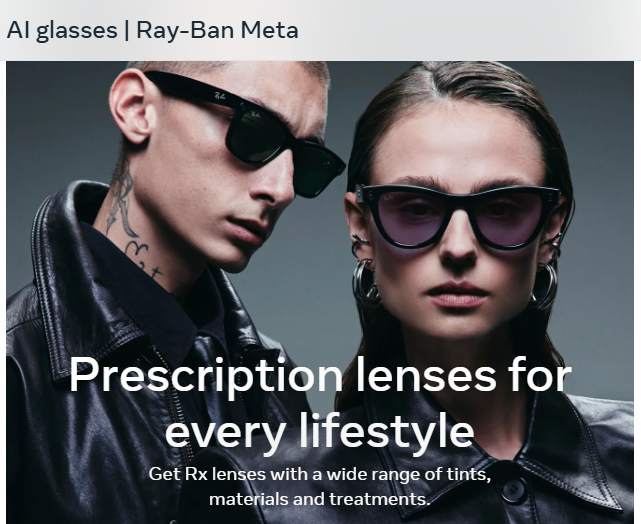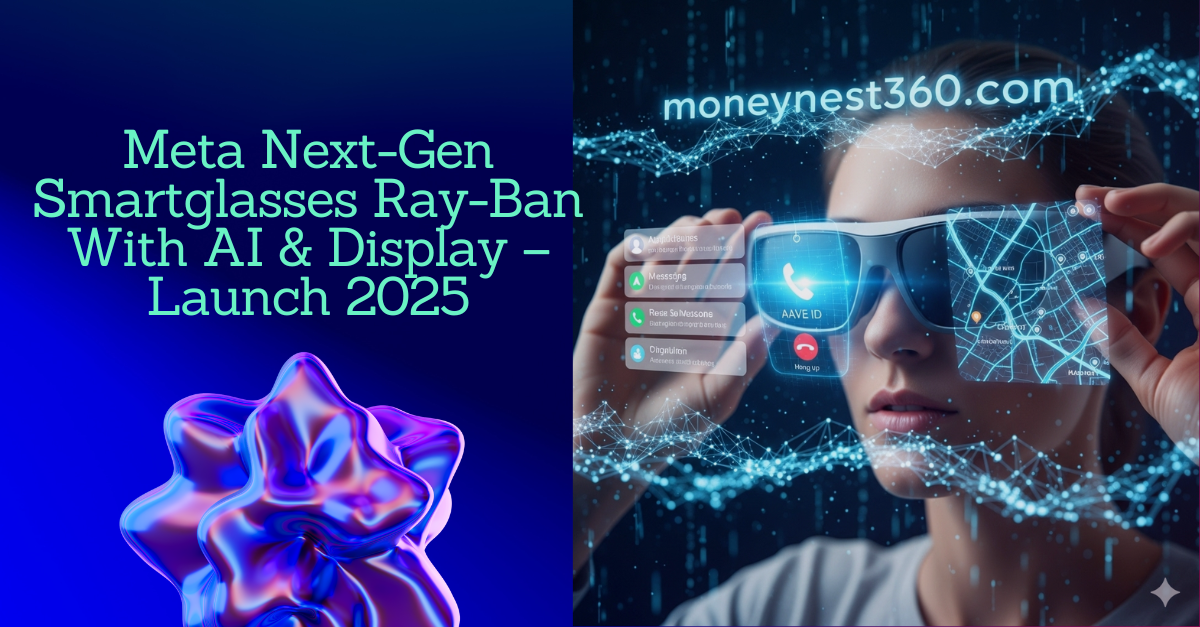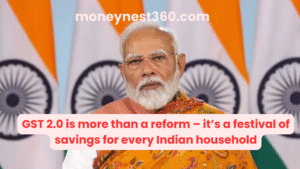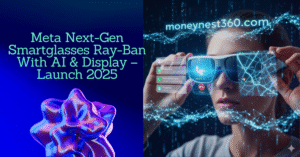Meta Launches Next-Gen Smart Glasses Ray-Ban AI Display:
At Meta Connect 17th Sep 2025, CEO Mark Zuckerberg unveiled the company’s boldest vision yet: the Meta Ray-Ban Display smart glasses, paired with a futuristic Neural Band wrist controller.
These aren’t just stylish glasses — they’re a computer on your face. For the first time, smart glasses bring together camera, audio, AI, and a full-color display, controlled by subtle finger movements.
Also Read: Meet Your New Money Boss: AI Financial Agents Ready to Run Your Entire Financial Life | Moneynest360
What’s New in Meta Ray-Ban Display?
Unlike earlier models, the new Ray-Ban Display brings together camera, speakers, microphones, compute power, AI, and now a full-color display into a single stylish device.
🎨 Full-Color Display – Appears only when you need it. No bulky screens — just glanceable, context-aware information.
✋ Neural Band Wrist Controller – Reads electrical signals from your wrist muscles (EMG). A tiny pinch of your fingers can scroll, zoom, or click.
🧠 AI With Visuals – Instead of just talking, Meta AI can show you answers, directions, captions, or translations directly in your lens.
🌍 Accessibility Breakthrough – Helps people with disabilities (like tremors or paralysis) by detecting micro-signals invisible to the human eye.
💪 Durability – Band made of Vectran, used in Mars rovers. Water-resistant (IPX7) and lasts 18 hours.
🎵 Everyday Features – WhatsApp messages, video calls, live captions, music, translations, navigation — all hands-free.

Neural Band: Turning Muscle Signals Into Magic
Meta’s Neural Band is more than just a controller — it’s a new way of interacting with technology.
- Replace touchscreens, buttons, and dials with finger gestures.
- Scroll, click, zoom, or even type in the near future using subtle wrist and finger movements.
- Built on research from nearly 200,000 participants to make it usable for almost anyone.
- Incredible sensitivity: can detect motion before it’s visible to the human eye.
For India, where accessibility and inclusivity are growing tech needs, this opens a new dimension: helping people with limited mobility or physical challenges interact naturally with AI.
What Can You Do With Meta Ray-Ban Display?
Here’s how the glasses blend AI, display, and gestures into daily life:
- Stay Connected: See WhatsApp, Messenger, or Instagram messages in your lens — no phone needed.
- Video Calls: Show friends exactly what you’re seeing via WhatsApp/Messenger live video.
- Perfect Photos & Videos: Use the real-time viewfinder & zoom before you capture.
- Navigate Cities: Get turn-by-turn pedestrian navigation visually on the lens (rolling out city by city).
- Break Language Barriers: Live captions and translations right in front of your eyes.
- Music On the Go: Swipe to skip, pinch to pause, or rotate your wrist to adjust volume.

Pricing & Availability
- Price: Starts at $799 (~₹66,000) including the glasses + Neural Band.
- Launch: September 30, 2025, in the U.S. (Best Buy, LensCrafters, Sunglass Hut, Ray-Ban stores).
- Global Expansion: Early 2026 in Canada, France, Italy, UK — India may have to wait a bit longer.
- Battery: ~6 hours on glasses + ~30 hours with charging case.
- Colors: Black & Sand; comes with Transitions® lenses (indoor + outdoor).
- Fit Options: Neural Band comes in three sizes; in-store fitting is required at launch.
Meta’s Three Types of AI Glasses
Meta is dividing its wearable AI lineup into three categories:
- Camera AI Glasses – Ray-Ban and Oakley models with cameras, AI features, and better creators’ tools.
- Display AI Glasses – The new Ray-Ban Display + Neural Band, focused on contextual displays and subtle interactions.
- AR Glasses (Future) – Meta’s Orion prototype, with large holographic displays for full augmented reality
Pros & Cons
✅ Advantages
- Works with WhatsApp & Messenger (huge in India and globally).
- Inclusive tech for people with disabilities.
- Fashionable compared to bulky AR headsets.
- AI + Display + Neural Band = first step beyond smartphones.
❌ Challenges
- Premium pricing (₹66K is luxury in India, mid-range in U.S./Europe).
- Battery (6 hours) may be short for power users.
- Limited launch markets (India may need to wait).
- Privacy debates — cameras in public spaces.
Why This Matters
Meta Ray-Ban Display is not just a gadget — it’s a step toward the post-smartphone era.
For Indian users, it may start as a luxury, but just like smartphones, prices could fall, and apps could evolve to make it essential. Imagine:
- Hands-free Paytm or UPI payments in the future.
- Translations across India’s 22+ languages.
- Live captions for classrooms, workplaces, and accessibility.
- Navigation in crowded cities like Mumbai or Delhi without staring at your phone
Conclusion
The Meta Ray-Ban Display isn’t just a gadget — it’s the future of wearable AI. With a display in your glasses and a Neural Band on your wrist, Meta is showing us the first glimpse of life beyond the smartphone.
For now, it’s for early adopters. But soon, whether you’re in New York, London, or New Delhi, this technology could change how you see — and interact with — the world.
👉 The big question: Would you wear your next computer on your face?
For more details about Ray-Ban Meta : Click here
Frequently Asked Questions
1. What are Meta Ray-Ban Display glasses?
Meta Ray-Ban Display is a new category of smart glasses with a built-in high-resolution display, AI features, camera, speakers, and seamless integration with apps like WhatsApp, Messenger, and Instagram.
2. What is the Meta Neural Band?
It’s a wristband that uses EMG (electromyography) technology to read subtle muscle signals from your wrist and fingers. This lets you control the glasses with tiny hand movements—like scrolling, pinching, or swiping—without touching the glasses or your phone
3. What can I do with these AI glasses?
- View WhatsApp & Messenger messages in the lens
- Make video calls hands-free
- Get real-time translations & captions
- Use AI to identify objects, get answers, or step-by-step instructions
- Navigate streets with turn-by-turn directions
- Control music with gestures
- Take photos/videos instantly
4. Are these glasses different from AR (Augmented Reality) glasses?
Yes. These are AI-powered display glasses, not full AR glasses. The display only shows contextual information (like messages, maps, translations) when needed—it’s not a full holographic overlay like AR
5. What is the price of Meta Ray-Ban Display glasses?
The starting price is $799 (around ₹66,000 in India), which includes both the glasses and the Neural Band.
6. When will they be available in India?
Currently, the launch is limited to the US (Sept 30, 2025), with expansion to Canada, France, Italy, and the UK in early 2026. Availability in India hasn’t been announced yet, but it could follow once global rollout expands.
7. How long does the battery last?
- Glasses: Around 6 hours of mixed use
- Charging case: Extends total battery life to about 30 hours
- Neural Band: Up to 18 hours, IPX7 water-resistant, and durable enough for daily wear.
8. Is it safe for privacy?
Meta has added privacy indicators like LED lights when recording. Still, like any device with a camera, privacy concerns exist—especially in public spaces.
9. How are these useful for Indians specifically?
- WhatsApp users (India’s largest communication platform) can check messages hands-free.
- Travelers can use real-time navigation and translation.
- Content creators can shoot Reels and Shorts easily.
- Accessibility users (stroke, tremors, or mobility challenges) can control devices using subtle finger signals.
10. Will Meta’s Ray-Ban Display glasses replace smartphones?
Not yet. These glasses are designed for quick, glanceable tasks—checking messages, navigation, translation—while keeping you present in the real world. Smartphones are still needed for full apps, typing, and larger tasks.








